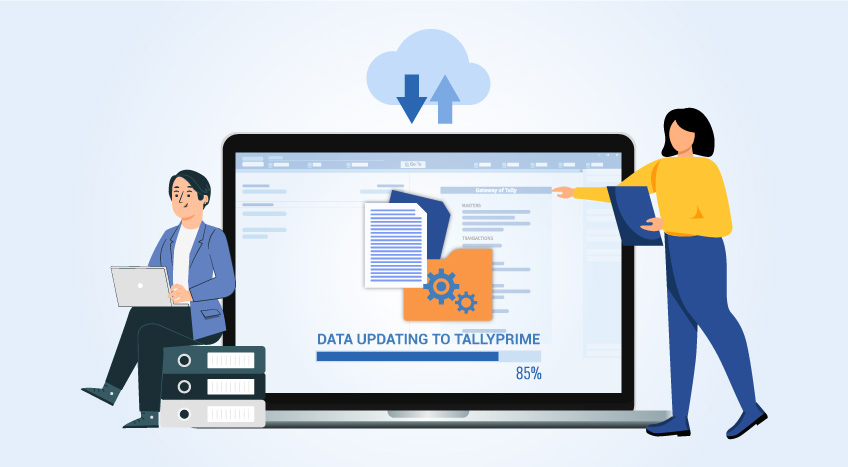Tally Solutions |Updated on: August 23, 2022
- What is deferred revenue?
- How deferred revenue works
- Example of deferred revenue
- Why companies record deferred revenue
- Cash from operating activities
When a company collects payment in advance for a product or service that has not been delivered, it is called deferred revenue. The treatment of deferred revenue in business accounting is different from a payment that has been made after delivery. This different treatment occurs when the revenue is earned in one accounting period, and its delivery is in a future accounting period. This presents a unique situation in which the accountant will have to treat the revenue differently when preparing the business financial reports and statements.
What is deferred revenue?
Deferred revenue is also called unearned revenue because it is a revenue payment that is received before the company has earned it by delivering the product or service. This presents a unique situation when the company uses accrual accounting. Accrual accounting requires that the revenue and matching expenses should be accounted for in the same accounting period. But when a company receives an advance in one accounting period and then delivers the goods or service in the next, there is no match of the revenue and expenses. When you receive a retainer or a booking amount for a service or product, this situation arises.
Accrual accounting recognizes a payment receipt as revenue only when earned. In reality, customers often make advance payments towards goods and services that have to be recorded in the books of accounts. So, instead of recording this deferred revenue as sales revenue, it is listed on the balance sheet as a liability and not recorded in the income statement.
Since the deferred revenue payment is received for a service or product that is yet to be delivered, it is a payment for something owed to the buyer or customer. This makes it a liability rather than revenue. As the product or service is delivered in portions or completely, the appropriate amount of deferred revenue is recognized on the company’s income statement. This is in line with the GAAP guidelines for accounting conservatism.
The balance sheet records the deferred revenue amount as a short-term or current liability as the service or product that is paid for is expected to be delivered in the short term. So, it is a debt that is owed to the customer or buyer. If the service or the product is not delivered, the money may be liable to be returned. The collection of the amount also means that the company owes the service or product to the buyer.
There is a difference between the deferred revenue and accrued expenses. They are both listed as a liability on the balance sheet. But deferred revenue is money received in advance for services/products not yet delivered, and accrued expenses are amounts for which the company has received services/products and has not paid for as yet.
An example of this could be a performance bonus that an employee who performs well earned every month. The amount is calculated and adds up but is only paid at the end of the defined period. Since the amount owed increases over time, it is an accrued expense and not a deferred revenue.
How deferred revenue works
Deferred revenue is categorized as a liability on company balance sheets. This is because the company has received the deferred revenue amounts as an advance. The company is then liable or obliged to deliver the service or product that the advance was paid for. If the company is unable to deliver the service or product, it may be liable to repay the amount that was collected as an advance unless there are other terms and conditions agreed upon in the contract between the buyer and seller.
Deferred revenue is unique to accrual accounting systems where there must be a matching of the expenses and revenues that relate to each other. However, if a business uses cash basis accounting, there is no worry about deferred accounting. The money you receive is recorded as soon as you receive it, and there is no need for any other adjustment or matching principle. You record the transaction exactly when it happens.
In accrual accounting, the receipt of payment can only be recognized as a revenue payment when the company has earned it. So, when an advance payment has been received, it is recorded as deferred revenue. When the company performs the actions that earn that revenue, it gets recorded as revenue, and this is called revenue recognition. The principle that states when money can be recorded as revenue is called the revenue recognition principle. The revenue recognition principles that are defined by Generally Accepted Accounting Principles (GAAP) for different business types and industries are the most commonly followed principles.
The principle of deferred revenue may be confusing to some as it uses the word ‘revenue’ but is classified as a liability. This is because the money has not been earned yet. It is an amount that is liable to be returned in case the company is not able to deliver the product or service. Some industries have very strict methods and principles by which they put aside the deferred revenue until it is earned.
The principle of deferred revenue is useful to prevent overvaluation of the business by including payments for deliverables that haven't been delivered yet. For example, a yearly subscription service may collect the entire yearly subscription upfront, but the services will be delivered over the next year. By using the deferred revenue system, the company’s accounts present a realistic picture of what it is actually worth and how it is performing through the year. It is also good accounting practice to be very discerning about the amounts that are classified as assets and liabilities on the financial records. Following the accounting principles ensures that liabilities such as the deferred liabilities are not misclassified as cash.
Example of deferred revenue
Deferred revenue is easier to understand with an example that shows each step and entry that is made.
A company agrees with a client to deliver a service for the next 12-months and collects the entire annual fee of $1200 upfront. So the company records a revenue of $0 for the month but creates an entry for the liability in the deferred revenue account amounting to $1200. The cash amount on the balance sheet increases by $1200.
|
Account |
Debit |
Credit |
|
Cash |
$1200 |
|
|
Deferred Revenue (Liability) |
|
$1200 |
After every month, the company records a revenue of $100, and the deferred revenue account gets reduced by $100. This recording of revenue and reduction of the deferred revenue continues for 12-months.
|
Account |
Debit |
Credit |
|
Deferred Revenue (Liability) |
$100 |
|
|
Revenue |
|
$100 |
At the end of the 12-month agreement period, the earnings or revenue of the company would have shown the entire $1200, and the deferred revenue from that particular transaction will be $0.
Why companies record deferred revenue
By the principles of accrual accounting, it is necessary to record deferred revenue when money is collected in advance of the product or service being delivered. It is recorded as a liability until the product or service has been delivered. If the product or service is delivered in installments, the proportional installment of the money recorded as deferred revenue is transferred to the company’s revenue account.
Cash basis accounting does not follow this principle and records the money as it is received. This is easier to maintain when customers are very volatile and changeable in their payments. However, it can artificially inflate the company’s value by showing such advance payments and subscriptions as revenue when they are yet to be earned.
Cash from operating activities
The deferred revenue principle also affects the cash flow statement. This statement would record the payment in the example above as cash from operating activities on the date when it was received. No adjustment entry is made in the cash flow statement.
Read More:
Latest Blogs

How to Easily Shift/Migrate Your Data to TallyPrime

Nuts & Bolts of Tally Filesystem: RangeTree

A Comprehensive Guide to UDYAM Payment Rules

UDYAM MSME Registration: Financial Boon for Small Businesses

Understanding UDYAM Registration: A Comprehensive Guide

MSME Payment Rule Changes from 1st April 2024: A Quick Guide


